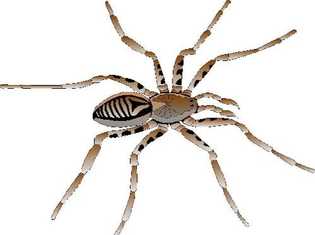クモと蛇 - Spiders and Snakes
In Japan, spiders are often found, and there are over 1,000 species. I, personally, dislike spiders, and the feeling seems to be mutual and universal. In the U.S., we have some very bad spiders who consume their mates. There are others which seem harmless, but all spiders are poisonous!
日本では、クモはよく見かける動物で、1000種類以上生息しています。私自身はクモが嫌いです。そして、この感情は世界中どこでも同じのようです。アメリカにはつがいの相手を食べてしまう恐ろしいクモも生息しています。一見無害に見えるクモもいますが、実はすべてのクモが毒を持っているのです。
The spider is often the villain or the pursued in dramas. This may be due to the old legend that a group of cave dwellers were said to live near Tokyo until the 7th or 8th century. They were called, “Tsuchigumo,” (earth spider), and later on, destroyed. In South America, there is the well-known “tarantula,” which sends chills down the back of anyone even seeing one. Then, there are snakes. I hate snakes, but they eat many rats and mice. In Japan, the habu of Okinawa and the mamushi are poisonous and well-known. The habu is very bad. The mamushi, even though poisonous, is used in medicines and drinks. I have neither eaten nor drunk any of them.
クモは、物語の中でよく悪役や追われる身として登場しますが、これは、7、8世紀まで現在の東京近郊で洞穴の中に住んでいたといわれる人々に由来しているようです。彼らは「土ぐも」と呼ばれ、後に滅ぼされました。南アメリカには悪名高い「タランチュラ」が生息していますが、これを見て背筋が凍らない人はいないでしょう。 私は蛇も嫌いですが、彼らはネズミを食べてくれます。日本では沖縄のハブとマムシが毒を持った動物として有名です。ハブはたいへん凶悪です。マムシも毒蛇ですが、薬や飲み物として用いられます。私はまだどちらも試したことがありません。
According to the ancient custom of telling ages with animals, snakes were supposed to be immortal, and were regarded as house guardian gods. This is similar to India where the same custom can be found. Especially, white snakes were highly respected in the old days. It is said that many can be found in the Sanin Area. One of the Seven Lucky Gods has a white snake! Her name is Benten Sama. Many old stories exist about snakes. Swords and snakes are often related in these stories. It is easy to see the relationship, since they are both long and slender.
各年を動物の名で表す古代の風習(十二支)において、蛇は不老不死の動物とされ、また、家の守り神でもあると考えられていました。インドにも同じような考え方、習慣が見受けられます。昔の人々はとりわけ白い蛇を崇拝しました。山陰地方にも数多く生息しているということです。そういえば、七福神の一人、弁天様も白い蛇を従えています。 蛇が出てくる昔話は数多く存在します。こうした物語では、しばしば剣と蛇が結び付けられて登場します。どちらも細くて長いという共通点のせいであることは明らかです。
There are two temples near Tokyo which have similar stories about snakes. One day a farmer went to a pond at Kitazawa, where he was frightened by a snake. He cut off the jaws of the snake with his sickle. The snake swam to a lake at Inokashira, where it died. The lake turned red then. The jawbone was enshrined at the Hosenji Temple at Nakano.
蛇について、とてもよく似た言い伝えが東京近郊の二つのお寺に残っています。ある日、一人の農民が北沢にある池に出掛けたところ、一匹の蛇が出てきました。農民はたいへん驚き、持っていたかまで蛇のあごを切り落としました。蛇は井の頭の池の中に飛び込み死んでしまいました。そして池の水が真っ赤に染まったのです。切り落とされたあごの骨は中野の保専寺に祭られました。
A similar story was told at Tatsumayama. Here, half of the snake’s jaw was placed in the Enshoji Temple at Kashiwagi and the other half at the Hosenji Temple of Nakano. At both temples, the bones were worshipped and many people still believe the story. In both stories, the snake died in Lake Inokashira. These old legends are interesting!
似たような話が竜間山にも残っています。ここに残る伝説によると、蛇のあごの骨の半分は柏木の円照寺に、もう半分は中野の保専寺にあるということです。どちらの寺院でも、人々は骨をあがめ、この話を実話だと信じています。そして、どちらの話でも蛇は井の頭の池で死んだとされています。古い伝説っておもしろいですね。
